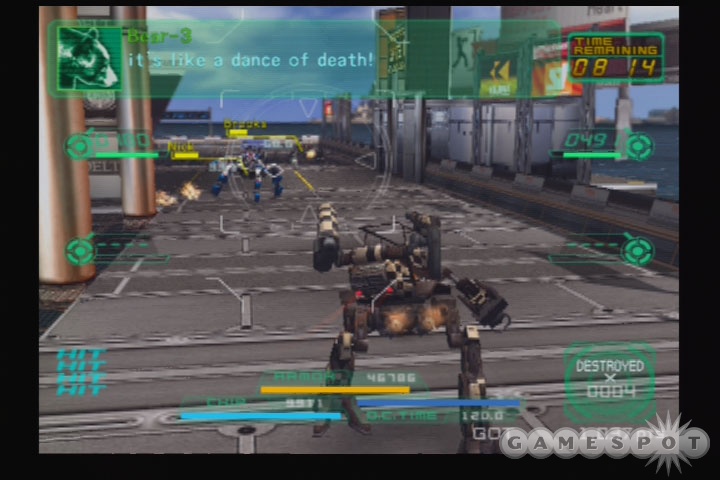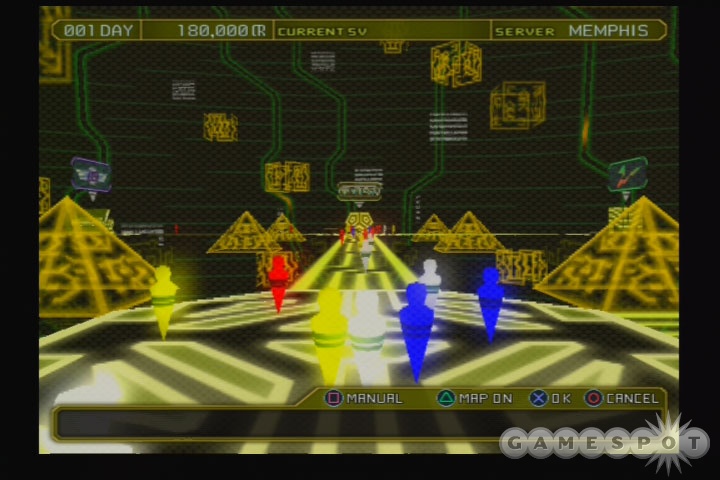Early in the Xbox's life cycle, Genki released a fun little robot-combat game called Phantom Crash. It earned itself a handful of fans, but didn't quite make the splash that the developer or publisher had hoped. Three years later and on another platform, Phantom Crash gives it another go, modified and renamed to Steel Lancer Arena International, or S.L.A.I. for short. S.L.A.I. maintains a lot of the same ideas from its predecessor--you start out as a cash-strapped but eager robot-jock looking to make a name for himself in the futuristic sport of "rumbling." You'll work your way up various ladders, earning cash to make more powerful mechs--or SVs as they're known in this game--with the ultimate goal of being the top-ranked rumbler in the world. S.L.A.I.'s fast-paced combat and accessible controls, combined with a lengthy story mode, make it one of the more enjoyable robot-combat games in recent memory.

S.L.A.I.'s story puts you in the year 2071. The new extreme sport taking the world by storm is "rumbling," or remote control combat with giant robots. The sport has seven major hubs around the world in major cities, like Hong Kong, Las Vegas, Cairo, and New York City. Each area has its own arena, and its own set of class rankings and ladders. The top rumblers from each city then take each other on in scheduled tournaments to determine the top pilot in the world. Your job is to make it to the top of each of the ladders in the seven cities, and then become the world's greatest rumbler. The characters you meet along the way, both pilots and artificial intelligence, provide a surprising amount of flavor and personality to the story.
You'll start off the story mode with enough cash to buy yourself a basic SV, and then you'll put yourself through battle school, which serves as a tutorial of sorts. Once you've finished school and earned the right to enter actual matches for rank and money, you'll need to pick a city server to start off your career. Yes, a server. You see, the back end of S.L.A.I. actually takes place in a Tron-like virtual world called HAVEN. Inside each of the servers, you can navigate your virtual avatar around and visit shops where you can spend money to upgrade your SV with new modules and weapons, repair your SV, or even pick out some of the game's catchy tunes to listen to as you play from the music shop. You can also examine the daily tournament schedule and see if you can find an appropriate level match to play in on any given day. Though abstracting what would normally be a dry menu system in this way is interesting at first, it feels more and more clunky and irritating as the game wears on. However, it's possible that forcing your virtual avatar to "navigate to a shop" is a sneaky way for the game to mask loading times for the assorted menus.
The combat model in S.L.A.I. is free-for-all arena matches. Each SV enters the arena and earns money for blowing up other SVs and also computer-controlled drone robots. As SVs are eliminated, more are let into the arena in order to fill out the match. You're actually able to escape arenas by running to an exit gate, but the tricky part is knowing how far you should push your luck before you should run away. Yes, the more SVs you kill in a match, the more money you earn. However, if you take too much damage or get destroyed before escaping, you might lose all of that money and even more on repairing your SV. The class matches you fight in complicate matters further, because you're required to kill all named opponents in the arena before the boss SV spawns in and you have an opportunity to advance in class. What's nice, though, is that you can escape an arena early in a class match, and the next time you try it, the server "remembers" which named enemies you've already defeated. This means you only need to concentrate on the new ones before spawning the boss.
Making your way up the ladders, earning money, and upgrading your SVs in story mode can be an extremely time-consuming affair. While the story mode is certainly lengthy, it can also be repetitive. Thankfully the combat in the game is fun enough to make up for that, assuming you're into this kind of game. The combat in S.L.A.I. is fast paced, and the control scheme is flexible enough to make you feel like you're piloting a nimble combat unit as opposed to a slow, plodding behemoth. SVs have four weapon units, and these can be outfitted with melee weapons, machine guns, missile launchers, lasers, and more. Each of the guns can be fired independently, and these gun controls are sensibly mapped to the four shoulder buttons of the Dual Shock controller. You can also jump for short distances with most SVs, as well as activate a Predator-like optical camouflage. Stealth plays a big role in S.L.A.I., because sneaking up and attacking SVs from behind gives you big damage bonuses.

Presentation-wise, S.L.A.I. is about what you'd expect from a robot combat game. Missiles swoop through the air to their targets, explosions and connecting shots offer up sparks and other particle effects, while the SVs themselves offer a fair amount of detail. The HUD interface is also generally clean and bereft of useless clutter--most of the gauges and meters you see serve a real purpose and keep your attention focused on the fight itself. The frame rate can get a little stuttery here and there, but for the most part, the game looks good. Sound effects are also on par with most action games, ranging from explosions to the rat-a-tat of machine guns and your other weapons. The music also varies from server to server and most of it is pretty catchy stuff.
S.L.A.I. does offer head-to-head, split-screen play as well as online multiplayer for up to six players in a match. You can bring in any SV you've built in story mode, or pick from a handful of preconfigured SVs in non-ranking fights. The interesting thing about online play is that only four players can be in the arena at once. Two will spectate until one of the players is knocked out, and then you'll be thrust into the arena. It's an odd concept, but it mimics the style of matches you play in the single-player mode. In our testing, matches ran fairly smoothly, although the game does let you connect to both domestic and Japanese players, so you might want to be aware of whether or not you're connecting to a foreign server.
If you enjoy the robot combat genre, S.L.A.I. is a perfectly worthy choice. The game's single-player story mode will keep you busy for quite a while as you work your way up the various ladders and continue to upgrade and customize your SVs. Online multiplayer offers a nice diversion as well as a way for you to show off your story mode creation. Players who are interested in robot combat but are not quite as experienced may also find S.L.A.I. to be a good starter game. The pacing and controls are accessible for the most part, but you'll just need to be careful not to go broke while starting off the story mode.